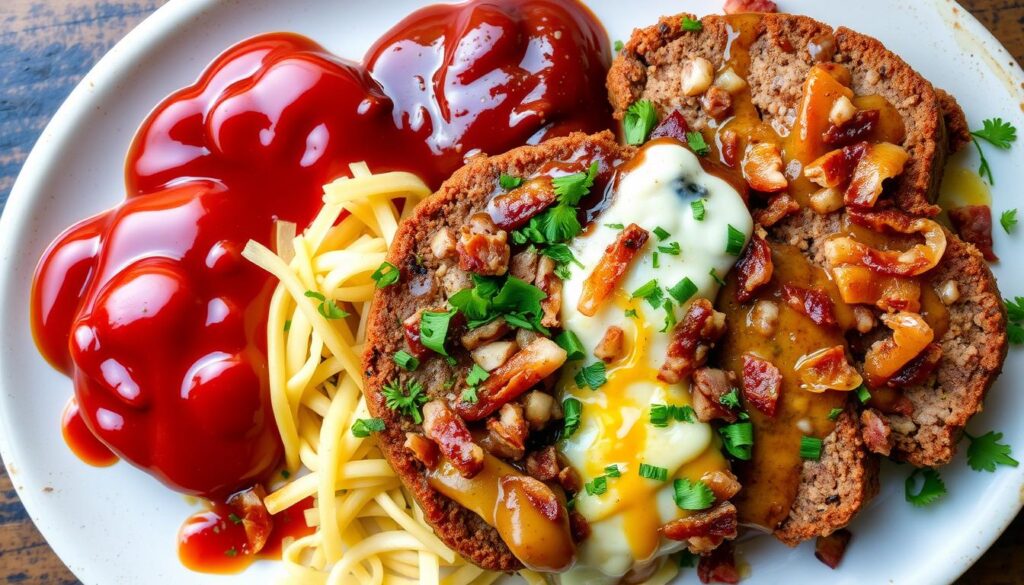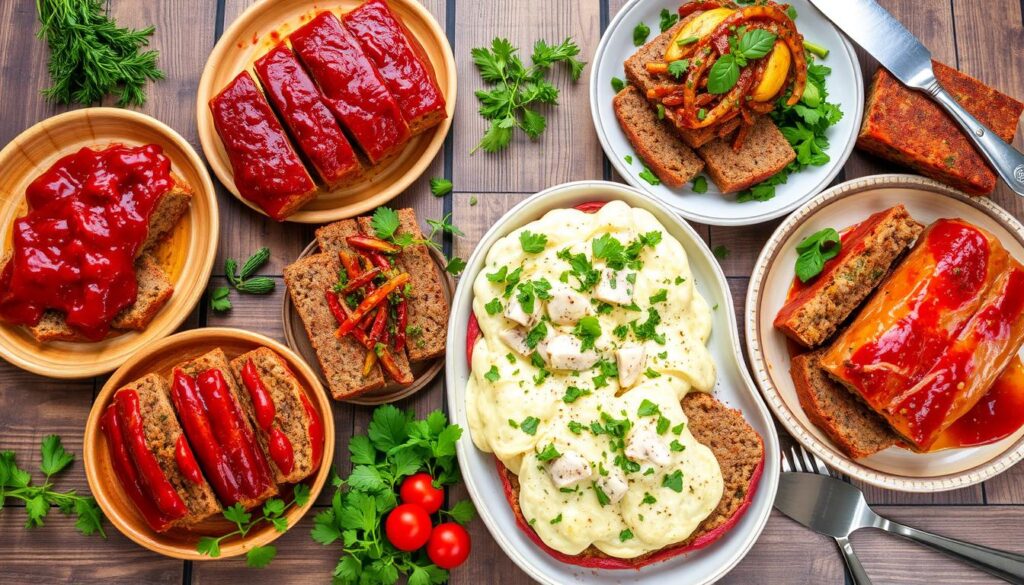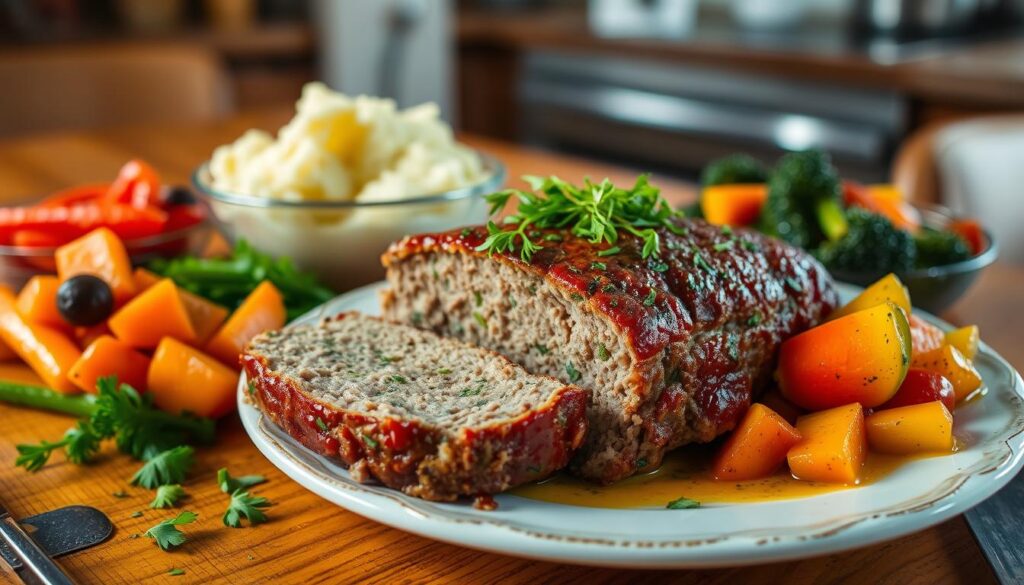This savory meatloaf recipe is a delicious and satisfying dinner option for the whole family.
Table of Contents
A delicious meatloaf recipe is the perfect comfort food for a satisfying dinner that the whole family can enjoy. With its rich flavor and tender texture, this dish is sure to become a staple in your household. When it comes to dinner recipes, a classic meatloaf recipe is a great option for a comforting meal.
This article will provide a comprehensive guide to making a delicious and satisfying meatloaf, covering everything from essential ingredients to cooking times and temperature guidelines, making it a valuable resource for anyone looking for new dinner recipes or comfort food ideas.
The History and Evolution of Classic Meatloaf
Meatloaf has a rich history in American cuisine, dating back to the late 19th century. The concept of mixing ground meat with other ingredients and shaping it into a loaf originated in Europe, but it was in the United States that meatloaf became a comfort food staple. Over time, meatloaf history has been shaped by various regional and cultural influences, resulting in a diverse range of recipes and cooking styles.
The evolution of meatloaf in American cuisine can be attributed to the country’s melting pot of cultures. As immigrants from different parts of the world arrived in the United States, they brought with them their own unique cooking traditions and ingredients. This blending of cultures has resulted in a wide range of meatloaf variations, from the classic American-style meatloaf made with ground beef and ketchup, to more adventurous versions featuring ingredients like chorizo and salsa.
Origins of Meatloaf in American Cuisine
One of the key factors that contributed to the popularity of meatloaf in American cuisine was its affordability and accessibility. During the Great Depression, meatloaf became a staple in many American households because it was an inexpensive and filling meal option. The use of ground meat, which was often cheaper than other cuts of meat, made it possible for families to enjoy a hearty and satisfying meal without breaking the bank.
How Meatloaf Became a Comfort Food Staple
Meatloaf’s comfort food status can be attributed to its nostalgic appeal and emotional connection to family and tradition. For many Americans, meatloaf is a dish that evokes memories of childhood and home-cooked meals. The combination of ground meat, breadcrumbs, and ketchup, topped with a sweet and tangy glaze, creates a flavor profile that is both familiar and comforting.
As American cuisine continues to evolve, meatloaf remains a beloved comfort food that is both nostalgic and innovative. With its rich history, cultural significance, and versatility, meatloaf is a dish that will continue to be enjoyed by generations to come.
Essential Ingredients for the Perfect Meatloaf Recipe
When it comes to creating a delicious meatloaf, the right meatloaf ingredients are crucial. The foundation of a great meatloaf is high-quality ground meat, which can be beef, pork, or a combination of the two. The recipe requirements for a classic meatloaf typically include ground meat, binders like eggs and breadcrumbs, and fillers like onions and bell peppers.
To enhance the flavor of your meatloaf, you’ll need a variety of cooking essentials, including seasonings and spices. Some common seasonings used in meatloaf include salt, pepper, and paprika. You can also add other ingredients like garlic, Worcestershire sauce, and chopped herbs to give your meatloaf a unique flavor.
Here are some key meatloaf ingredients to keep in mind:
- Ground meat (beef, pork, or a combination of the two)
- Binders (eggs, breadcrumbs)
- Fillers (onions, bell peppers)
- Seasonings and spices (salt, pepper, paprika, garlic, Worcestershire sauce)
By using the right recipe requirements and cooking essentials, you can create a delicious and satisfying meatloaf that’s sure to please even the pickiest eaters. Remember to choose high-quality meatloaf ingredients and follow a tried-and-true recipe to ensure the best results.
| Ingredient | Quantity |
|---|---|
| Ground beef | 1 pound |
| Eggs | 2 |
| Breadcrumbs | 1 cup |
Kitchen Tools and Equipment Needed
To prepare a delicious meatloaf, it’s essential to have the right kitchen tools and cooking equipment. This includes a variety of kitchen tools, such as stand mixers, wooden spoons, and measuring cups, which will help you mix and prepare the ingredients efficiently. Investing in quality cooking equipment, like meatloaf pans, will also ensure that your meatloaf is cooked evenly and to perfection.
When it comes to meatloaf pans, there are several options to choose from, including metal and glass pans. Metal pans are ideal for achieving a crispy crust on the outside, while glass pans allow for even cooking and easy monitoring of the meatloaf’s progress. Some popular brands for meatloaf pans include Calphalon and Pyrex.
In addition to kitchen tools and cooking equipment, temperature monitoring equipment is also crucial for ensuring that your meatloaf is cooked to a safe internal temperature. A meat thermometer is a must-have tool in any kitchen, as it allows you to check the internal temperature of the meatloaf quickly and accurately. Some popular brands for meat thermometers include Taylor and ThermoPro.
Essential Mixing Tools
- Stand mixers
- Wooden spoons
- Measuring cups
Best Loaf Pans for Meatloaf
- Metal pans
- Glass pans
Temperature Monitoring Equipment
- Meat thermometers
| Kitchen Tool | Description |
|---|---|
| Stand mixer | A versatile kitchen appliance used for mixing and kneading ingredients |
| Meat thermometer | A tool used to check the internal temperature of the meatloaf |
| Meatloaf pan | A specialized pan designed for cooking meatloaf |
Step-by-Step Meatloaf Preparation Guide
To begin the meatloaf preparation, it’s essential to follow a cooking guide that ensures proper food safety and handling techniques. This will help prevent cross-contamination and foodborne illness. Start by preheating the oven to the recommended temperature, usually around 350°F to 375°F, as indicated in the recipe instructions.
Next, prepare the ingredients according to the recipe instructions. This includes finely chopping the onions, garlic, and any other vegetables, as well as measuring out the correct amounts of meat, breadcrumbs, and seasonings. In a large bowl, combine the ground meat, chopped vegetables, and seasonings, mixing well with your hands or a wooden spoon until just combined. Be careful not to overmix, as this can lead to a dense meatloaf.
Now, shape the mixture into a loaf and place it in a loaf pan or on a baking sheet lined with parchment paper. Place the meatloaf in the preheated oven and bake for the recommended amount of time, usually around 45 to 60 minutes, or until the internal temperature reaches 160°F. During the meatloaf preparation, it’s crucial to follow the cooking guide and recipe instructions to achieve the perfect dish.
Here are some key steps to keep in mind during the meatloaf preparation:
- Preheat the oven to the recommended temperature
- Prepare the ingredients according to the recipe instructions
- Mix the ingredients just until combined
- Shape the mixture into a loaf and place it in the oven
- Bake for the recommended amount of time, or until the internal temperature reaches 160°F
By following these steps and the cooking guide, you’ll be able to create a delicious and satisfying meatloaf that’s sure to please. Remember to always follow proper food safety and handling techniques to ensure a safe and enjoyable dining experience.
Mastering the Art of Meatloaf Seasoning
Meatloaf seasoning is a crucial aspect of creating a delicious and satisfying meal. The right combination of herbs and spices can elevate the flavor profile of your meatloaf, making it a truly unforgettable experience. When it comes to meatloaf seasoning, there are several key elements to consider, including the type of meat used, the level of spice desired, and the overall flavor profile you want to achieve.
A good meatloaf seasoning blend should include a mix of salt, pepper, and other spices that complement the natural flavor of the meat. Some popular spice combinations for meatloaf include paprika, garlic powder, and onion powder. These spices add a rich, savory flavor to the meatloaf without overpowering it.
Herb and Spice Combinations
Herbs like thyme, rosemary, and parsley can also be used to add fresh, bright flavors to your meatloaf. These herbs pair well with the richness of the meat and can help to balance out the flavor profile. When using herbs, it’s best to use them in moderation, as they can quickly overpower the other flavors in the dish.
Creating the Perfect Flavor Profile
To create the perfect flavor profile for your meatloaf, it’s essential to consider the type of meat you’re using and the level of spice you prefer. For example, if you’re using a leaner meat like turkey or chicken, you may want to add more spices to compensate for the lack of fat. On the other hand, if you’re using a richer meat like beef or pork, you may want to use fewer spices to avoid overpowering the natural flavor of the meat.
Salt and Seasoning Guidelines
When it comes to salt and seasoning, it’s essential to use them judiciously. Too much salt can overpower the other flavors in the dish, while too little can leave the meatloaf tasting bland. A good rule of thumb is to use a light hand when seasoning your meatloaf, and to taste as you go to ensure the flavors are balanced. By following these guidelines and experimenting with different spice combinations, you can create a meatloaf that is truly unforgettable.
Glazes and Toppings to Enhance Your Meatloaf
When it comes to meatloaf, the right glazes and toppings can make all the difference in terms of flavor and appearance. Meatloaf glazes can add a rich, sweet, or tangy flavor to your dish, while toppings can provide a satisfying crunch or creaminess. Some popular meatloaf glazes include ketchup-based and BBQ sauce-based options, which can be brushed on during the last few minutes of cooking.
For added texture and flavor, consider using toppings such as bacon, cheese, or chopped herbs. These flavor enhancers can be sprinkled on top of the meatloaf before or after cooking, depending on the desired effect. Here are some ideas for meatloaf toppings:
- Bacon bits or chopped cooked bacon
- Shredded cheese, such as cheddar or mozzarella
- Chopped fresh herbs, such as parsley or thyme
- Caramelized onions or bell peppers
By experimenting with different meatloaf glazes and toppings, you can create a unique and delicious flavor profile that suits your tastes. Whether you prefer a classic ketchup-based glaze or something more adventurous, the right combination of glazes and toppings can elevate your meatloaf to the next level.

Some popular flavor enhancers for meatloaf include Worcestershire sauce, soy sauce, and hot sauce. These can be added to the meat mixture before cooking or used as a topping after cooking. With so many options available, you’re sure to find the perfect combination of glazes and toppings to enhance your meatloaf.
| Glaze/Topping | Flavor Profile | Texture |
|---|---|---|
| Ketchup-based glaze | Sweet and tangy | Smooth |
| BBQ sauce-based glaze | Smoky and sweet | Thick |
| Bacon bits | Savory and smoky | Crunchy |
Cooking Times and Temperature Guidelines
When it comes to cooking meatloaf, cooking times and temperature guidelines are crucial to ensure food safety and a perfectly cooked dish. To achieve this, it’s essential to understand the importance of internal temperature and resting time.
A meatloaf is considered cooked when it reaches an internal temperature of at least 160°F (71°C). It’s recommended to use a food thermometer to check the temperature, especially when cooking a large meatloaf. The resting time, which allows the juices to redistribute, is also vital for a tender and flavorful meatloaf.
Proper Internal Temperature
The internal temperature of a meatloaf can vary depending on the size and type of meat used. As a general guideline, a small meatloaf (1-2 pounds) should be cooked at 350°F (180°C) for about 45-60 minutes, while a larger meatloaf (3-4 pounds) should be cooked at 325°F (165°C) for about 1-1.5 hours.
Resting Time Recommendations
After cooking, it’s essential to let the meatloaf rest for at least 10-15 minutes before slicing. This allows the juices to redistribute, making the meatloaf more tender and flavorful.
Troubleshooting Common Temperature Issues
Some common temperature issues that can arise during cooking include overcooking or undercooking the meatloaf. To avoid this, it’s crucial to monitor the internal temperature and adjust the cooking time accordingly. If the meatloaf is overcooked, it can become dry and tough, while undercooking can lead to food safety issues.
| Meatloaf Size | Cooking Temperature | Cooking Time |
|---|---|---|
| 1-2 pounds | 350°F (180°C) | 45-60 minutes |
| 3-4 pounds | 325°F (165°C) | 1-1.5 hours |
By following these temperature guidelines and cooking times, you can ensure a delicious and safe meatloaf that’s perfect for any occasion. Remember to always prioritize food safety when cooking, and don’t hesitate to consult a food thermometer if you’re unsure about the internal temperature.
Creative Variations of Traditional Meatloaf
Meatloaf is a versatile dish that can be adapted to various tastes and dietary needs. One way to add excitement to this classic recipe is to explore different meatloaf variations, such as international recipes that incorporate unique flavors and ingredients.
Some popular international recipes include Italian meatloaf, made with ground beef, pork, and Italian seasonings, and Mexican meatloaf, which adds a spicy kick with jalapenos and salsa. These variations can be a great way to experience new flavors and cuisines.
In addition to international recipes, there are also many healthy alternatives to traditional meatloaf. For example, using ground turkey or chicken can reduce the fat content, while adding vegetables like mushrooms and bell peppers can increase the nutrient density. These options can be just as flavorful and satisfying as the original recipe.

- Gluten-free meatloaf made with gluten-free oats and seasonings
- Low-sodium meatloaf using salt-free seasonings and herbs
- Vegetarian meatloaf made with black beans, mushrooms, and vegetables
| Meatloaf Variation | Ingredients | Description |
|---|---|---|
| Italian Meatloaf | Ground beef, pork, Italian seasonings | A classic Italian-inspired meatloaf with a rich tomato sauce |
| Mexican Meatloaf | Ground beef, jalapenos, salsa | A spicy and flavorful meatloaf with a Mexican twist |
| Turkey Meatloaf | Ground turkey, mushrooms, bell peppers | A healthier alternative to traditional meatloaf, made with ground turkey and vegetables |
Serving Suggestions and Side Dishes
When it comes to serving meatloaf, there are numerous serving suggestions to consider. One popular option is to slice the meatloaf and serve it with a rich, flavorful gravy. This classic combination is sure to please even the pickiest of eaters.
In addition to gravy, there are many side dishes that complement meatloaf perfectly. Some popular options include mashed potatoes, roasted vegetables, and creamy coleslaw. These meal ideas can help to create a well-rounded and satisfying dining experience.
Here are some additional serving suggestions to consider:
- Serve meatloaf with a side of garlic bread for a comforting, indulgent treat
- Offer a variety of side dishes, such as roasted sweet potatoes or green beans, to cater to different tastes and dietary needs
- Use meatloaf as the centerpiece for a meal idea, such as a classic comfort food dinner or a hearty, satisfying brunch
By considering these serving suggestions and side dishes, you can create a delicious and memorable dining experience that is sure to please even the most discerning palates. Whether you’re serving a classic meatloaf or trying out a new meal idea, the key is to have fun and be creative with your serving suggestions and side dishes.
| Side Dish | Description |
|---|---|
| Mashed Potatoes | A classic comfort food side dish that pairs perfectly with meatloaf |
| Roasted Vegetables | A healthy and flavorful side dish that complements the rich flavor of meatloaf |
| Creamy Coleslaw | A cool and refreshing side dish that provides a nice contrast to the warm, savory flavor of meatloaf |
Storage and Leftover Ideas
When it comes to storing meatloaf, there are several storage methods to consider. Proper storage is crucial to maintain the quality and safety of the meatloaf. Refrigeration and freezing are two common storage methods used to keep meatloaf fresh for a longer period.
Reheating guidelines are also essential to ensure food safety. It is recommended to reheat meatloaf to an internal temperature of at least 165°F (74°C) to prevent foodborne illness. Creative leftover recipes can help reduce food waste and provide a delicious meal. Some ideas include meatloaf sandwiches, meatloaf soup, and meatloaf pasta bake.
Proper Storage Methods
Refrigeration is a great way to store meatloaf for a short period. It is recommended to store meatloaf in a covered container and keep it refrigerated at a temperature of 40°F (4°C) or below. Freezing is another option for longer-term storage. Meatloaf can be frozen for up to 3 months. When freezing, it is essential to wrap the meatloaf tightly in plastic wrap or aluminum foil to prevent freezer burn.
Reheating Guidelines
Reheating meatloaf can be done in several ways, including oven, microwave, and stovetop. It is crucial to follow reheating guidelines to ensure food safety. The internal temperature of the meatloaf should be at least 165°F (74°C) before serving.
Creative Leftover Recipes
There are many creative ways to use leftover meatloaf. Some ideas include:
- Meatloaf sandwiches: Slice the meatloaf and serve on a bun with your favorite toppings.
- Meatloaf soup: Chop the meatloaf and add it to a soup with vegetables and broth.
- Meatloaf pasta bake: Chop the meatloaf and add it to a pasta bake with tomato sauce and cheese.
By following proper storage methods and reheating guidelines, you can enjoy your meatloaf for a longer period. Creative leftover recipes can help reduce food waste and provide a delicious meal. Remember to always prioritize food safety when storing and reheating meatloaf.
| Storage Method | Temperature | Shelf Life |
|---|---|---|
| Refrigeration | 40°F (4°C) | 3-5 days |
| Freezing | 0°F (-18°C) | 3 months |
Conclusion
As we conclude our exploration of the beloved meatloaf recipe, it’s clear that this classic dish has stood the test of time, evolving and adapting to the ever-changing tastes and preferences of American cuisine. From its humble origins to its rise as a comforting staple, meatloaf has cemented its place in the hearts and homes of families across the nation.
Through the insights and techniques shared in this comprehensive guide, home cooks can now confidently embrace the art of crafting the perfect meatloaf, leveraging high-quality ingredients, precise cooking methods, and innovative flavor combinations. By mastering the fundamentals and experimenting with creative variations, you can elevate this time-honored dish to new heights, infusing it with your own personal flair and garnering rave reviews from family and guests alike.
As you continue on your meatloaf journey, remember to stay curious, embrace experimentation, and never be afraid to put your own unique spin on this timeless culinary classic. The possibilities are endless, and the rewards of a perfectly executed meatloaf are truly unparalleled. Happy cooking!



